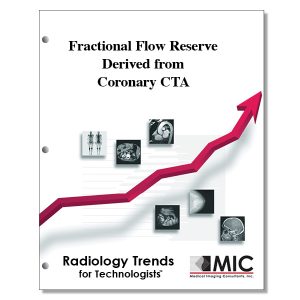

Fractional Flow Reserve Derived from Coronary CTA
A description of the scientific principles, clinical validation, and implementation of fractional flow reserve derived from standard coronary CT angiography.
Course ID: Q00565 Category: Radiology Trends for Technologists Modalities: Cardiac Interventional, CT, Nuclear Medicine3.0 |
Satisfaction Guarantee |
$34.00
- Targeted CE
- Outline
- Objectives
Targeted CE per ARRT’s Discipline, Category, and Subcategory classification for enrollments starting after December 10, 2024:
[Note: Discipline-specific Targeted CE credits may be less than the total Category A credits approved for this course.]
Cardiac-Interventional Radiography: 1.50
Procedures: 1.50
Diagnostic and Electrophysiology Procedures: 1.50
Computed Tomography: 1.00
Procedures: 1.00
Neck and Chest: 1.00
Nuclear Medicine Technology: 1.00
Procedures: 1.00
Cardiac Procedures: 1.00
Registered Radiologist Assistant: 3.00
Procedures: 3.00
Thoracic Section: 3.00
Outline
- Introduction
- Invasive FFR Determination
- Noninvasive Modalities for the Functional Evaluation of CAD
- Noninvasive FFRCT
- Current Evidence
- Diagnostic Accuracy and Validation
- Intermediate Stenosis
- Calcification
- Clinical Implications
- Impact on Patient Care
- Treatment Planning Based on Virtual Stent Placement
- Cost-effectiveness and Quality of Life
- Contextualization and Comparison of FFRCT with Other Noninvasive Functional Tests
- Limitations
- Future Outlook and Conclusion
Objectives
Upon completion of this course, students will:
- identify the reference standard technique for diagnosis of CAD
- understand the outcomes related to FFR values
- be familiar with how invasive FFR measurements are determined
- identify the methods of administrating vasodilators during FFR
- be familiar with the use of FFR-informed treatment decision making
- be familiar with the reasons FFR may be underutilized
- be familiar with MPI SPECT imaging
- identify the limitations of MPI SPECT imaging
- identify the limitations of MR cardiac imaging
- be familiar with the evolution of CT angiography
- be familiar with current CT imaging techniques for myocardial perfusion
- be familiar with TAG
- be familiar with correction models when using TAG
- be familiar with the diagnostic accuracy of TAG
- be familiar with the computation of fractional myocardial mass
- identify the study on the diagnostic performance of fractional myocardial mass
- be familiar with postprocessing techniques used in FFRCT
- identify the factors that make FFRCT possible
- identify the equations used to calculate FFRCT values
- identify the models to overcome the limitations of 3D models when calculating FFRCT
- be familiar with the deep learning algorithm
- be familiar with the DISCOVER-FLOW trial
- be familiar with the findings in the DISCOVER-FLOW trial
- be familiar with the DeFACTO trial
- understand the outcomes of the DeFACTO trial
- be familiar with the details surrounding the NXT trial
- be familiar with the improvement in accuracy when using FFRCT
- be familiar with the meta-analysis study conducted on FFRCT
- identify the outcomes of the NXT trial to reclassify patients correctly
- be familiar with the impact of workstation-based FFRCT on intermediate stenosis
- be familiar with the impact of coronary calcification on FFRCT calculations
- be familiar with impact FFRCT can have on patient care
- understand the impact FFRCT can have on reducing unnecessary ICA procedures
- be familiar with the outcomes of the RIPCORD trial
- understand the impact FFRCT can have on treatment strategy
- be familiar with the utility and impact of FFRCT on decision making and down stream testing
- identify the study conducted that demonstrated the utility of FFRCT to predict the functional outcome of percutaneous coronary intervention
- be familiar with research that is focusing on comparing FFRCT with other noninvasive diagnostic tests
- be familiar with the limitations of FFRCT
- be familiar with the advantages of FFRCT as a single noninvasive test
